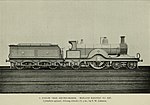File:Midland Railway No. 116; A Jubilee Year Record-Maker. The Engineering Magazine, XV-1, April 1898, New York, p. 97 – No caption.jpg

Original file (3,271 × 2,031 pixels, file size: 2.91 MB, MIME type: image/jpeg)
Captions
Captions
Summary[edit]
| DescriptionMidland Railway No. 116; A Jubilee Year Record-Maker. The Engineering Magazine, XV-1, April 1898, New York, p. 97 – No caption.jpg |
English: Midland Railway 115 Class 4-2-2 no 116 in photographic grey livery Image is a scan of: |
| Date |
before 1898 date QS:P,+1898-00-00T00:00:00Z/7,P1326,+1898-00-00T00:00:00Z/9 |
| Source | https://archive.org/stream/factoryindustria15newy/factoryindustria15newy#page/97/mode/1up |
| Author | Unknown authorUnknown author |
| Other versions |
|
Licensing[edit]
| Public domainPublic domainfalsefalse |
This work was published before January 1, 1929 and it is anonymous or pseudonymous due to unknown authorship. It is in the public domain in the United States as well as countries and areas where the copyright terms of anonymous or pseudonymous works are 95 years or fewer since publication.
|
File history
Click on a date/time to view the file as it appeared at that time.
| Date/Time | Thumbnail | Dimensions | User | Comment | |
|---|---|---|---|---|---|
| current | 14:13, 16 January 2020 |  | 3,271 × 2,031 (2.91 MB) | Alias Sobriquet (talk | contribs) | User created page with UploadWizard |
You cannot overwrite this file.
File usage on Commons
The following 5 pages use this file:
- User:Mattbuck/Railways/2020 January
- File:Factory and industrial management (1891) (14577697547).jpg
- File:Midland Railway No. 116; A Jubilee Year Record-Maker. The Engineering Magazine, XV-1, April 1898, New York, p. 97 – No caption, black and white.jpg
- File:Midland Railway No. 116; A Jubilee Year Record-Maker. The Engineering Magazine, XV-1, April 1898, New York, p. 97 – No caption.jpg
- File:Midland Railway No. 116; A Jubilee Year Record-Maker. The Engineering Magazine, XV-1, April 1898, New York, p. 97 – With caption.jpg
Metadata
This file contains additional information such as Exif metadata which may have been added by the digital camera, scanner, or software program used to create or digitize it. If the file has been modified from its original state, some details such as the timestamp may not fully reflect those of the original file. The timestamp is only as accurate as the clock in the camera, and it may be completely wrong.
| Orientation | Normal |
|---|---|
| Horizontal resolution | 72 dpi |
| Vertical resolution | 72 dpi |
| Software used | QuickTime 7.7.1 |
| File change date and time | 13:31, 10 January 2020 |
| Exif version | 2.2 |



